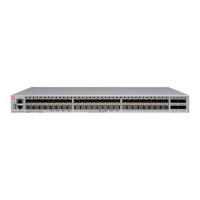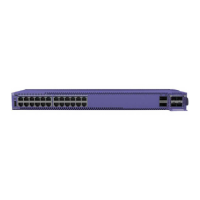Overview of the Switches
The following sections describe the ExtremeSwitching switches and summarize the features available in
each series.
Model numbers for the switches are in the following format:
<Series>-<number of front-panel I/O ports><port type><internal power supply type>
•
The number of ports ranges from 8 to 72.
•
The port type can be t (copper), p (copper providing PoE), q (QSFP+), or x (fiber).
•
For models with integral power supplies, the power supply type can be AC (no designation) or DC.
Models with pluggable power supplies can accommodate either AC or DC supplies and have no
power designation in their model numbers.
Note
See the ExtremeXOS 22.6 User Guide and the ExtremeXOS 22.6 Command Reference Guide
for feature-specific information about the Summit switches and for information regarding
switch configuration.
Combination Ports and Failover
ExtremeSwitching switches provide 2, 4, or 12 uplink ports implemented as combination ports that pair
a copper port using RJ45 connectors with an optical port using LC connectors.
The copper port operates as an autonegotiating 10/100/1000BASE-T port. The optical port allows
Gigabit Ethernet uplink connections through Extreme Networks small form factor pluggable (SFP)
interface modules. See the individual switch descriptions for the port numbers of the combination ports
on each switch model.
ExtremeSwitching switches support automatic failover from an active fiber port to a copper backup or
from an active copper port to a fiber port. If one of the uplink connections fails, the Summit uplink
connection automatically fails over to the second connection. To set up a redundant link on a
combination port, connect the active 1000BASE-T and fiber links to both the RJ45 and SFP interfaces
of that port.
Gigabit Ethernet uplink redundancy on the ExtremeSwitching switches follows these rules:
•
With both the SFP and 1000BASE-T interfaces connected on a combination port, only one interface
can be activated. The other is inactive.
•
If only one interface is connected, the switch activates the connected interface.
•
The switch determines whether the port uses the fiber or copper connection based on the order in
which the connectors are inserted into the switch. When the switch senses that an SFP and a copper
connector are inserted, the switch enables the uplink redundancy feature. For example, if you first
connect copper ports x and y on a switch, and then insert SFPs into ports x and y, the switch
assigns the copper ports as active ports and the fiber ports as redundant ports.
Hardware identifies when a link is lost and responds by swapping the primary and redundant ports to
maintain stability. After a failover occurs, the switch keeps the current port assignment until another
ExtremeSwitching Switches
ExtremeSwitching and Summit Switches: Hardware Installation Guide 11

